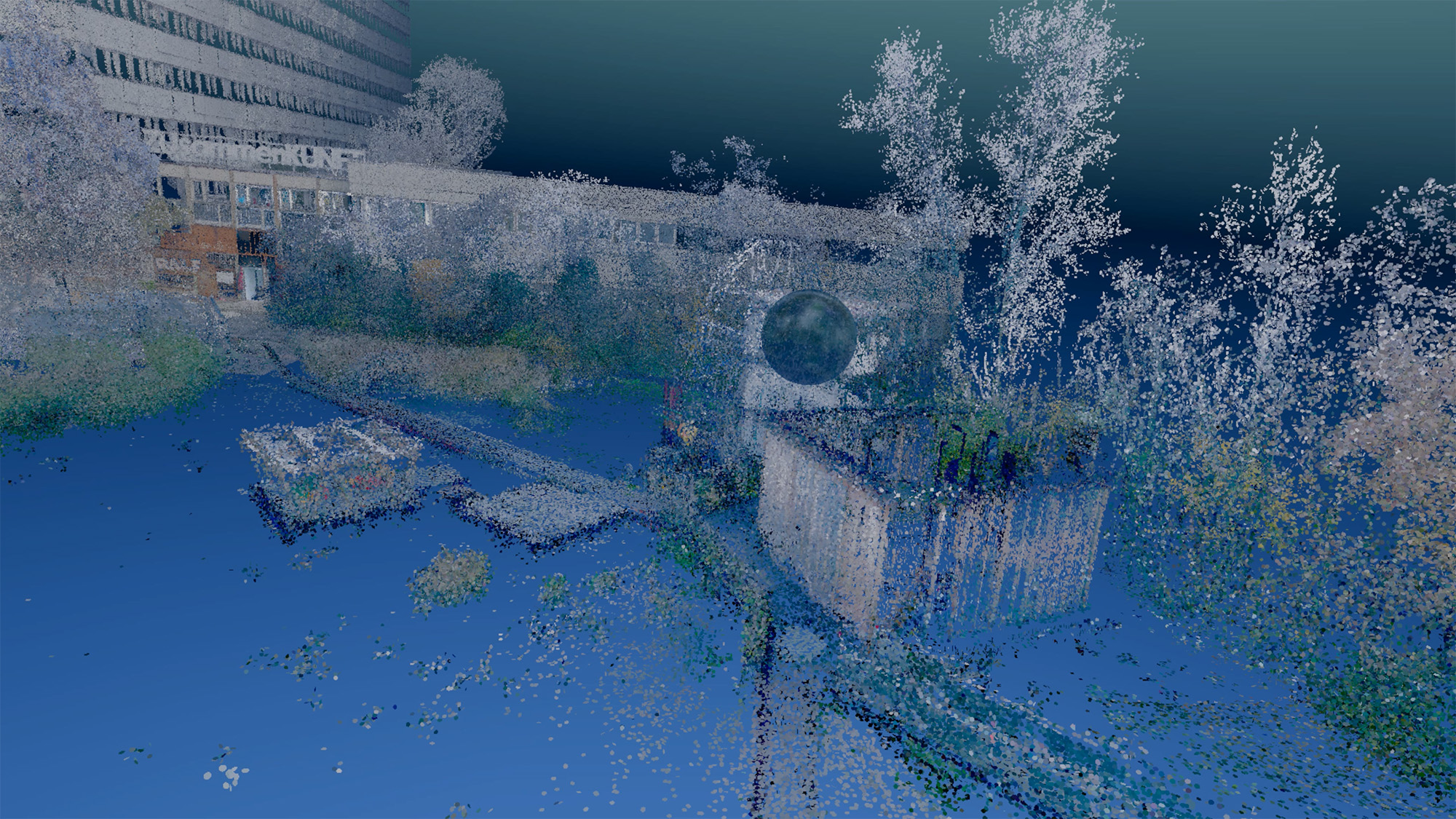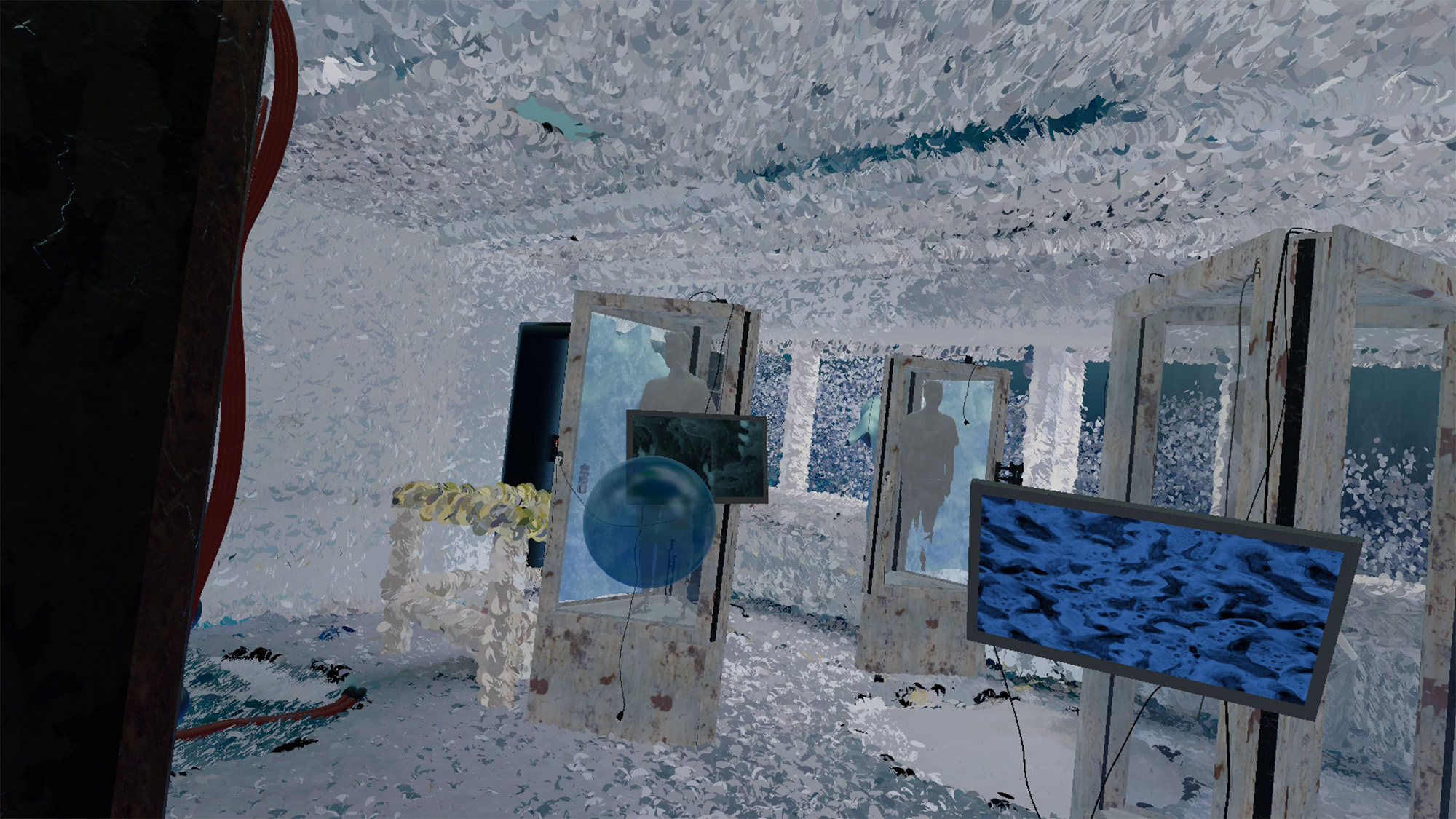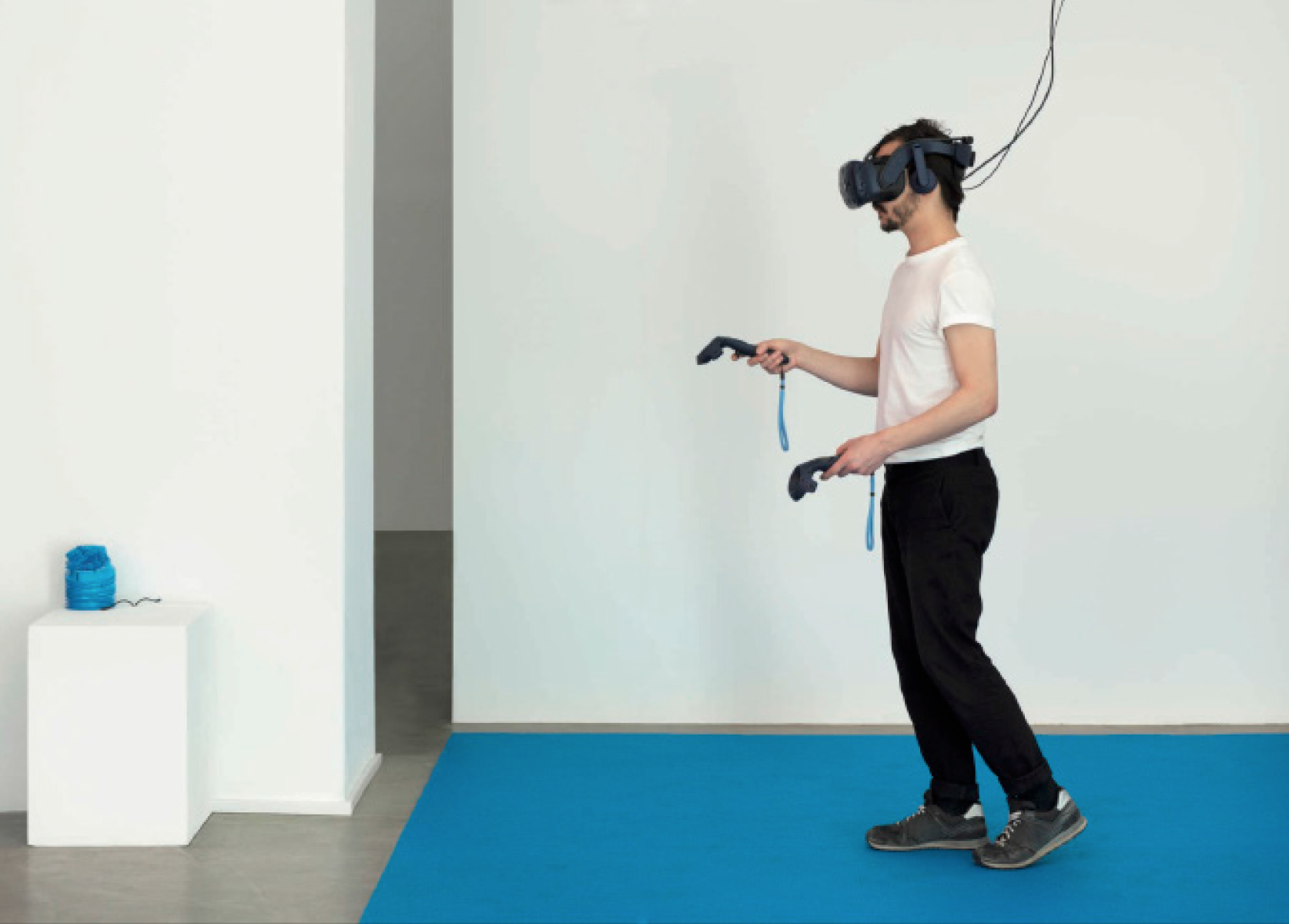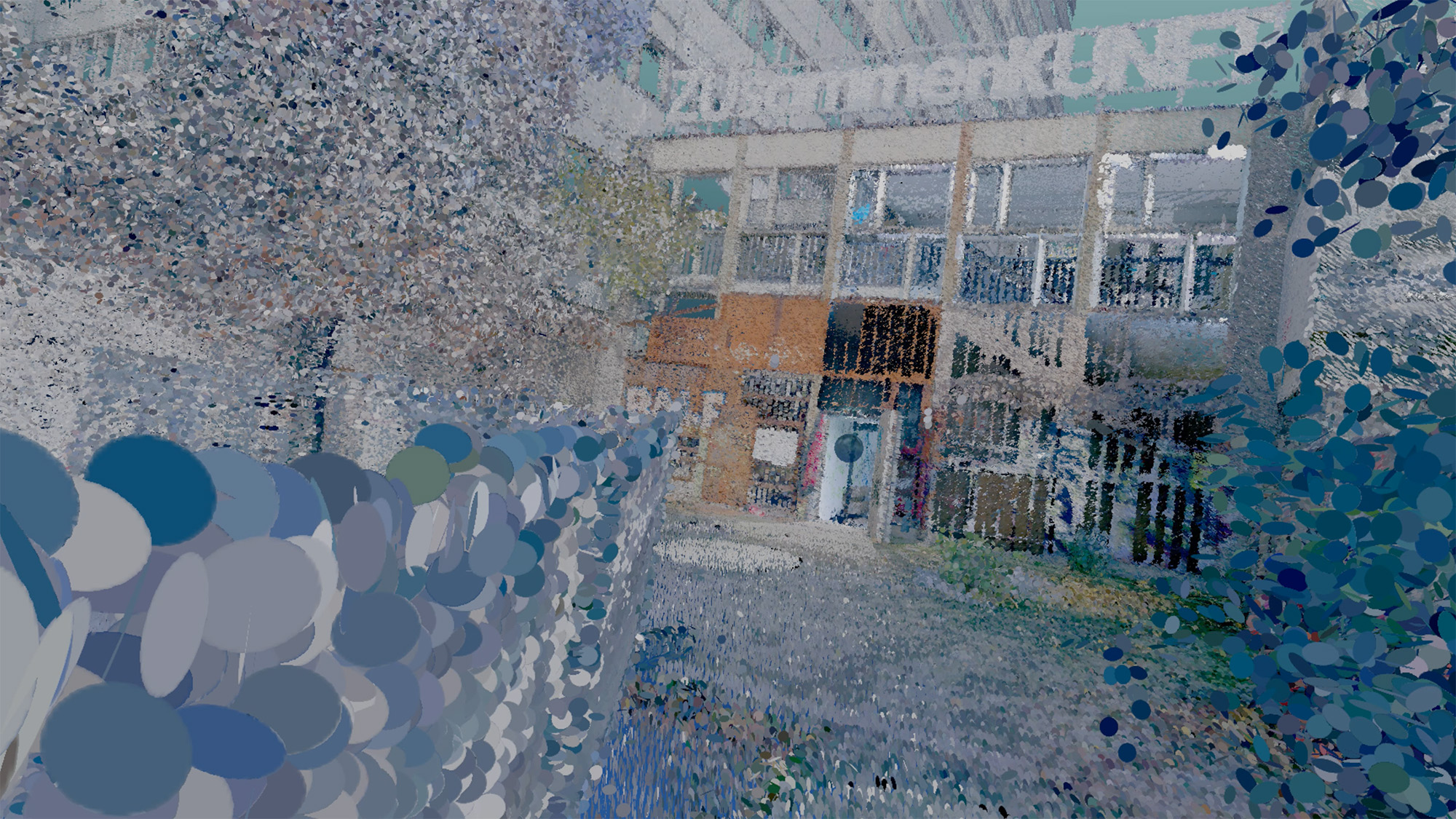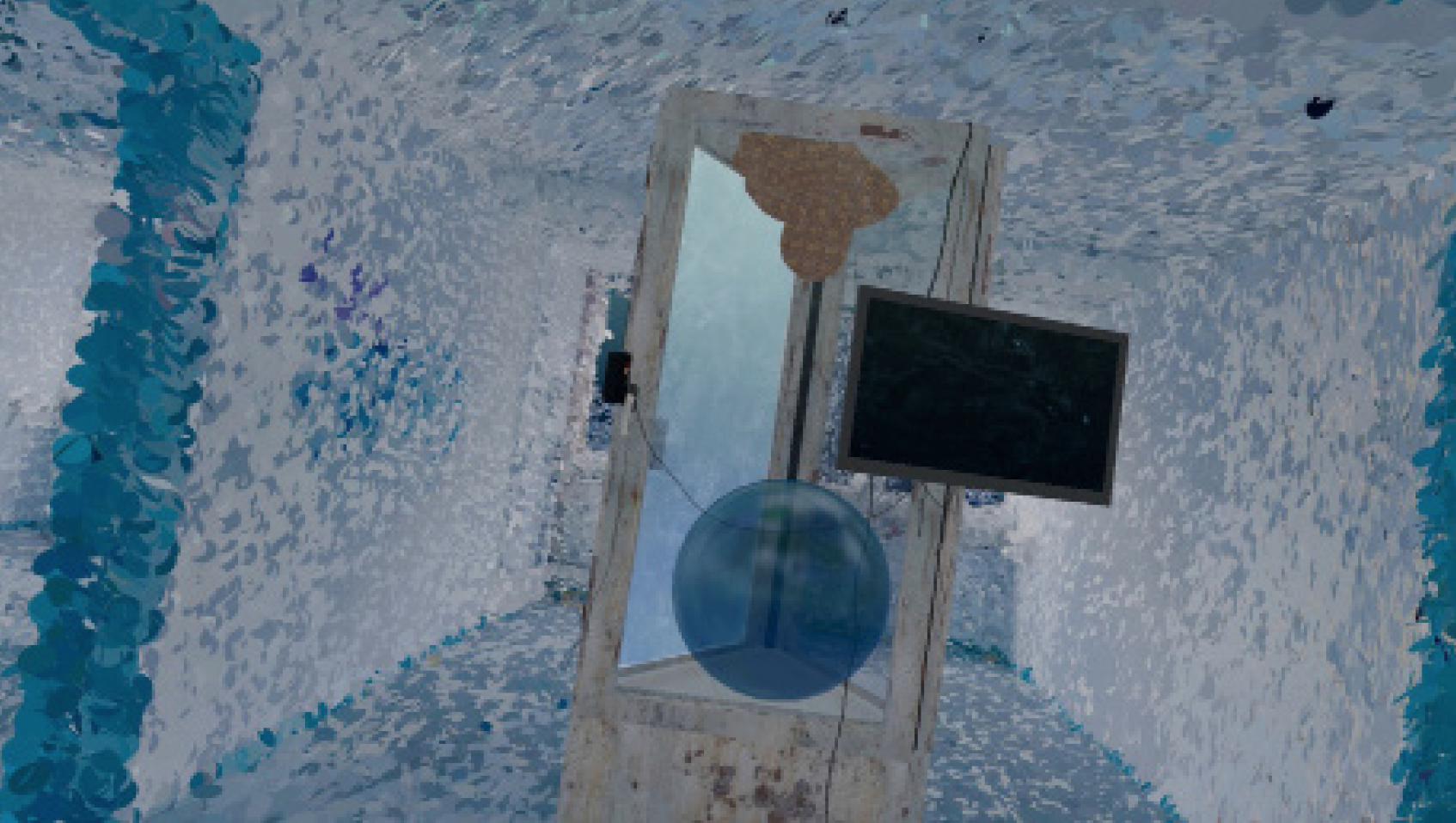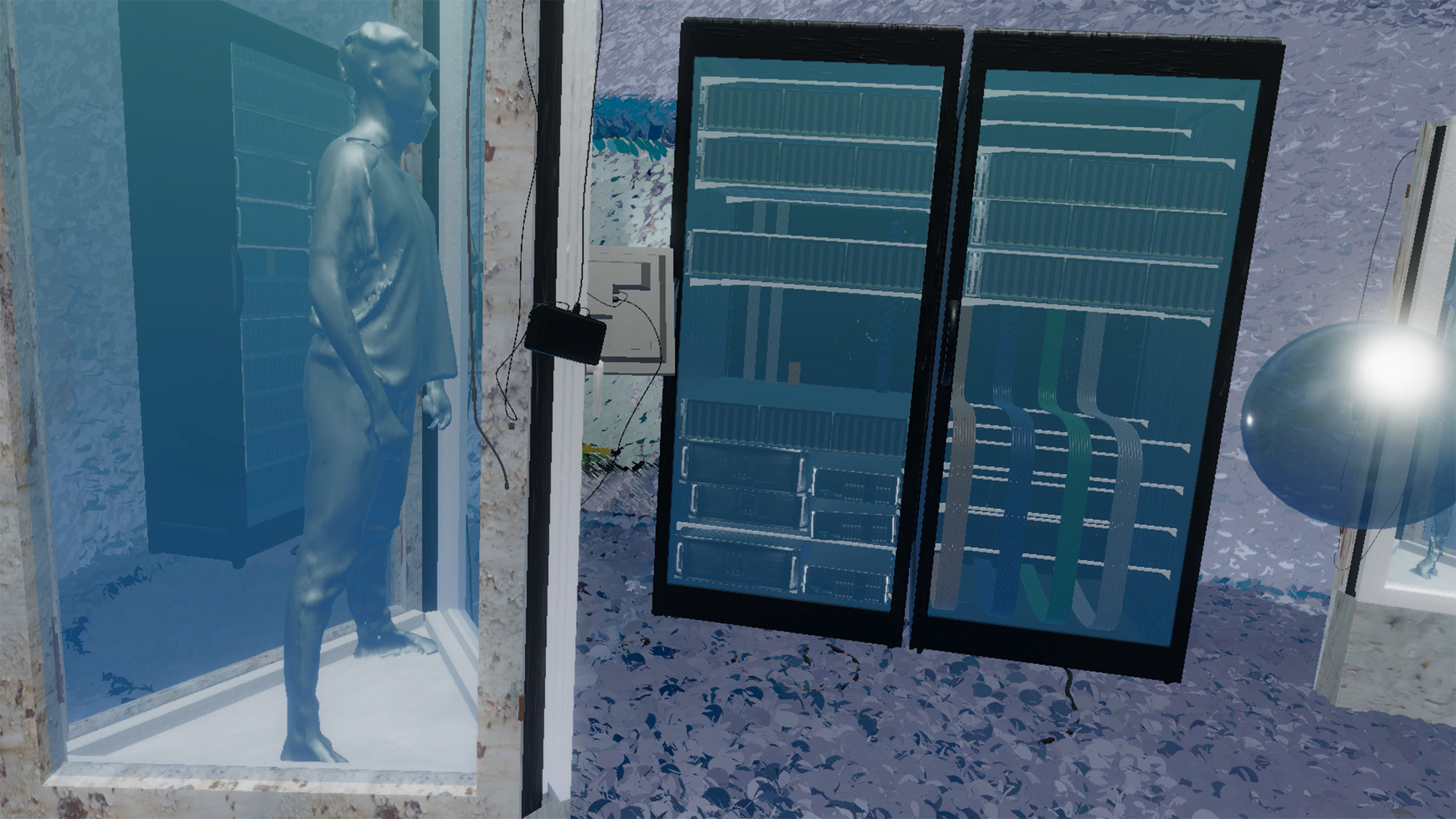Doireann O’Malley: Floating Worlds Apart

Doireann O’Malley, New Maps of Hyperspace, 2020, a blue painted room, blue carpet, silver vinyl wall text, HTC Vive Pro Virtual Reality kit, including headset, removable masks, 2 sensors, VR ready PC, 196.85 x 196.85 inches [courtesy of the artist]
Share:
When I moved to Los Angeles a year ago, Google Maps was my trusted guide through the anonymous, pandemic-struck city as I set up shop in my new home. I surprised myself with my reluctance to stop using maps. It took several months to accept the vulnerability of navigating on my own, and to welcome the possibility of losing my way.
Berlin-based artist Doireann O’Malley considers the experience of being lost to be a clarifying one. O’Malley’s recent work, New Maps of Hyperspace_Test_01 (2020), the final installment of their trilogy series Prototypes, looks to the future to better understand the present. The video presents a post-human reality in which the digital is an “extension of memory.” The viewer uses a computer trackpad to explore 360 degrees of the hyperspace, floating through an apocalyptic environment in a genderless body. It’s horrifying, meditative, and incredibly engrossing. O’Malley’s virtual, imaginary cartographies allow viewers to transcend the obligation to use a map as they are thrust into an untraceable exploration of the unconscious.
Lydia Horne: I am curious about how you conceive of getting lost and how you integrate that into your work. I’ll let you interpret this in whatever way you see most fit—when was the last time you felt lost?
Doireann O’Malley: Wow. That is an interesting question. One could say the experience of having a lack of concentration, or gender dysphoria, or being disconnected with one’s immediate environment, [are] all experiences of being lost, which I would connect to. I guess those kinds of oscillations of affective dysfunction—and how that formulation of functioning or dysfunctioning—are really connected, for me, to that experience of feeling lost. And how attachment or feelings of safety and security are kind of bound up to conceptions of being lost and found, and how that is then connected to the soul, or the idea of being connected to others, or oneself.
You asked that, but I think that just a while ago—I’m sitting here with my assistant, Oliver. (Oliver: [waves] “Hi. Hello.”)—just a while ago we were working, and I was dazing out, and I realized, Let’s go down and sit by the river and meditate. I guess that was the last moment of being lost. Then we meditated, and in that moment, I was there, and I was realizing how easy it is to slip into beating oneself up about [whether] you are meditating or not. I ended up just kind of gazing into this succulent. There was this weird mass of succulents there. Then I was lost in that for a while. Yeah, it’s an interesting question, because I think, really, it is about oscillating between entities or objects to [ground] oneself to not being lost in the unconscious.
Doireann O’Malley, New Maps of Hyperspace, installation detail, 2020, 3D rendering [courtesy of the artist]
LH: You conceive of being lost as disconnection from your immediate environment. I’m curious if you think there is value to getting lost, and if so, how you might have integrated that into your conception and building of the hyperspace.
DO: Yeah. That is interesting, as well. Because numerical values, or the value of [a] formula or spatial or mathematical equation in relation to, maybe, the expansion or compression of space is something interesting. Because if you really conceptualize value as something, that is the experience—or meaningful experience—of any entity that is projected onto, or from within or without.
So, with New Maps of Hyperspace_Test_01, I made the series of works … called Prototypes. The first is the three-screen installation, and the second is the two-screen installation. I always [imagine] that there is the appearance of a viewer headset in Prototype I [Quantum Leaps in Trans Semiotics through Psycho-Analytical Snail Serum], in the beginning, when there is a character sitting in front of two or three screens, and is hypothetically building a 3-D environment or viewer environment. My conceptualization of this work would be that, eventually, the last part would be virtual reality work. But as I, three to four years later, came to the end of that series, it was just before the pandemic, actually. I had imagined that that work would be about a world without gender, so a CGI world where there would be all types of different creatures and visualizations of post-gender beings.
Then I came to the point of thinking a lot about consciousness in the psyche, or potentially the body, or if it’s a projection from outside, from systems and social constructions. I really had got to the point where this world without gender wouldn’t have any bodies in it, so it would be a post-human world that, maybe, is only inhabited by machines and consciousness. It went back to the exploration of Alan Turing and thinking about the whole basis of questioning AI, and how machines think, and embodiment and gender, which had started my exploration of these topics within Prototype I. Linking it back to Alan Turing and the question, Can machines think? was something that I entered into with New Maps of Hyperspace_Test_01. Then I sort of conflated it with Terence McKenna and his talk “New and Old Maps of Hyperspace.” With this thinking, or this container, McKenna and this text became a reflexivity in relation to virtual embodiment. McKenna so specifically speaks about hyperspace as a mapping of different texts [onto] spiritual and psychic and mystical environments that we can inhabit in the psyche. Then, how to transcend the body, though? Specifically, in his text, his research is [on] psilocybin and psychedelics and traumatic experience. I thought about this usage of VR as a gateway medium into a psychedelic or transcendent experience. In Prototype II [The Institute on UVP’s platform], at the end of the film there is a portal and a character, who I envisioned to be Alan Turing, standing in front of the portal, potentially entering the portal. In New Maps of Hyperspace_Test_01—it is Prototype III—you enter the map through a portal.
I’ve just begun showing the work at an exhibition, and it was such an amazing experience. I’ve only shown the work once, [in] the beginning of lockdown, in February 2020. Only a limited amount of people experienced it, except for people in my studio. I don’t know how many people saw it, but there was definitely a couple of hundred over the opening weekend. I did two tours, and within those, there [were] 50 or 80 people within each. I did a demo, and it was just a constant cycle of people. That was really amazing to see. There was one person there [who was] also in the show, and when I looked back, about 30 or 40 minutes later, they were still in there. Afterwards, I spoke to him, and he said that he was lying on the ground and flying, and had moved himself around the space, as well. He said that if there is a conception of God, you’ve just outdone what I would imagine God to be.
I think, what you are asking about being lost—some people really get lost in there. I have obviously spent a lot of time in there, and [seen] friends who really have rang[ed] from being nauseous to having mystical experiences. I did want the freedom of movement. I chose to use … the six degrees of movement, rather than being confined to three degrees, in order for people to fly, to really experience the whole environment. But also, then, the parameters of being connected to the ball and having a game-like path, with something, like you say, where there were restrictions. It is about agency as well, in these systems [in which] we’re given the fallacy that we have freedom, or that we have agency to make decisions—like with gender, also. We have these restrictions placed [by] society, or [by] religion or capitalism.
Doireann O’Malley, New Maps of Hyperspace, installation detail, 2020, 3D rendering [courtesy of the artist]
LH: Do you conceive of the hyperspace as a means to an end? Is it a mapping device to arrive somewhere that perhaps is discrete and unique to each individual’s experience? Or is the hyperspace the ultimate destination?
DO: I think the notion of hyperspace is very embedded in our individual experiences of transversing the unconscious and the real. I think that is what’s super interesting about McKenna’s explorations of hyperspace as a concept, and how it relates to different spiritual practices which are mediums to experience hyperspace, I think. Especially, then, also mediums of psychotropic plants and shamanic experiences.
In New Maps of Hyperspace_Test_01, I think the ball is also a metaphor for a goal. There is a goal to get to the end of the story. That could be seeking to get someplace, to the revelation of the unknown. That goal, within making this work, was just a metaphor as well for all these hypothetical journeys to that outcome. I think with this [work], there is no outcome, except you come to these suggestions about death and the unconscious. Then, to be let into this blue screen of death and this nightmarish or dystopian experience of being stuck within a machine, and how that relates to [whether] one’s consciousness is then uploaded into the machine, or the 2045 Strategic Social Initiative, or these projects of transhumanism. This endgame was a goal because it stops there. That is why I called it a test, as well. A test zero one, because it could be one of many propositions or dystopian outcomes.
Doireann O’Malley, These Are the Only Times You Have Known, installation view, 2020 [courtesy of the artist and Neuer Berliner Kunstverein, Berlin]
LH: In assigning visuals to the hyperspace, did you feel any anxiety about the authority you had to determine what it might look like?
DO: No, because I think, as artists, we have the authority to visualize in endless capacities and propositions. I don’t think that is something that creates anxiety … because I don’t have the access to visualize an unended scope of possibility for what the afterlife could look like—or a world without gender.
[The work] had a limited budget and a limited time frame. I worked with a 3-D modeler, and someone [else] was scanning, and [there was] also a coder. We had a limited amount of time, and limitations in the scope—and with the technology, as well. Because, with VR, there are limitations, especially with the crew, time, and budget. Those limitations set the parameters for the visualization. We [used] LiDAR scanning technology, which I find fascinating, as well, in terms of how [the technology] was being used to reveal the Mayan ruins, for example. [Researchers] are flying above the Amazon rainforest, and that reveals a lot of the unknown ruins that are just beneath the surface—[so,] rather than having to excavate in the forest now, they can use LiDAR scanning.
I find that [technology], as a tool to reveal [what] is hidden, super interesting. I used it to scan two spaces in Berlin, two liminal environments, one being the Haus der Statistik, which used to house the archive of statistics in the GDR, on the data of the inhabitants [at that] time. That—as a kind of archive, or a kind of relic—was fascinating for me. The Haus der Statistik is … being gutted to rehouse social and artistic projects. [It] could’ve been sold to commercial bidders, like most spaces in Berlin after the fall of the Berlin Wall. This multifunctional use of public space and the possibility of how to use that space is something I am invested in.
In my new work, Hyperbodies in Hyperspace, I’m working with collaborators on a performance and VR environment. I’m also really interested in how to redistribute funding and representation—in a way, assembling these structures. Just going back to your original question, then, about the authority to visualize these things—that [authority] is a very privileged position to be in. The anxiety comes from, How will this be perceived? Or, How will people critique that? But in the end, it’s about, How do we work together? Because, for me, it’s more anxiety-producing to make a VR work, with a certain budget, that goes back to, Who does that [work] redistribute the funding to? And, In what way does it affect people?—on a material level. It is really interesting for me to see how it definitely affects people to experience VR in that way—in a more pragmatic way. I don’t want to just make CGI work, that, in the end, is the snake eating the [tail] of technology and the dystopian ways that it is being used. The billionaire technocrats are having this dystopian effect on the environment. All of these usages and distributions [are things] that I am really interested in—[and] also, using new technologies to explore them. For me, it is more interesting to work with people, and that is anxiety-inducing, too, because it is really challenging to deconstruct the structural imbalances.
Doireann O’Malley, New Maps of Hyperspace, installation detail, 2020, 3D rendering [courtesy of the artist]
LH: I think that many of the issues you have identified that plague our society are bodiless forces—whether capitalism or data mining, or even Covid. Are these forces more nefarious, in that they are bodiless? How did you assign a visual to them when building the hyperspace?
DO: Yeah, I think it was incredibly coincidental that Covid happened just before I finished this work. This kind of implosion of time is something that is implicit in the work, as well, and how we inhabit time, in the real sense—and then, in the fantasy or in the unconscious. These immaterial phenomena that are being generated or constructed through [the] economy were definitely on my mind in making the work. I think that they are potentially proof—I think that proof is potentially a problematic word—but proof of the intangible in psychic space, and [of] how we, as humans, built this fourth dimension on the internet, and [created] speculative economics. Maybe, as you say, “nefarious,” in terms of [whether] these technologies for imagining, and these infrastructures, are used in different ways. And what are the possibilities for other types of embodying the world? That is, maybe, a little too utopian, but it is an interesting question that, of course, I cannot really answer.
Doireann O’Malley, New Maps of Hyperspace, installation detail, 2020, 3D rendering [courtesy of the artist]
LH: Is the hyperspace a collective projection of the future? Is it more about the individual, or is it more about community? If it was about community, is it a utopia?
DO: No, I think it is definitely a dystopian piece. But then, there are these utopic types, or euphoric experiences, built [into] the technology or the experience. But definitely, this work was about a kind of utopity, because I think there is kind of, maybe, irony when the sign going into the buildings [means] “together into the future.” These kinds of propositions—of building community, or building social space or communal space—are part of the work. But I don’t think I had an agenda for any types of propositions. I think it’s just a capsule, in itself, with a lot of metaphors. It is definitely an individual experience, which is, I think, dystopic.
Doireann O’Malley, New Maps of Hyperspace, installation detail, 2020, 3D rendering [courtesy of the artist]
LH: Can you expand on that a little more?
DO: Well, I guess if there is a simulation, or a simulated world that is machine-driven or machine-created, only by machines, which, in this case it is, it is not possible to disconnect machines, or AI, from humans. It is a human-made construction or media. But the work is an individual experience. It is not a multiplayer game. Because there are no bodies, I don’t think it can be about community. But it is about the remnants—the ruins of a civilization or an environment that machines built, and that still exist in that environment. Yet it has references to real spaces that are now defunct or in transitional periods. These kinds of in-between regimes or in-between times [are] really interesting for me. Because, if we are at the end of capitalism, then will that be a utopian, communal, new regime? Or will it be a post-capital speculative environment, which could be connected to the hyperspace, or to purely intangible phenomena?
Doireann O’malley, New Maps of Hyperspace, 2020, a blue painted room, blue carpet, silver vinyl wall text, HTC Vive Pro Virtual Reality kit, including headset, removable masks, 2 sensors, VR ready PC, 196.85 x 196.85 inches [courtesy of the artist]
Lydia Horne is a writer, teacher, and artist living in Los Angeles. She is currently pursuing her MFA in photography at California Institute of the Arts, where she produces multimedia work that incorporates surveillance video, fabric, film, and cake. Horne mentors students of all ages to strengthen their creative and academic writing through programs at Los Angeles Public Library, Problem Library, and 826 Valencia. Horne formerly worked at WIRED in San Francisco.
